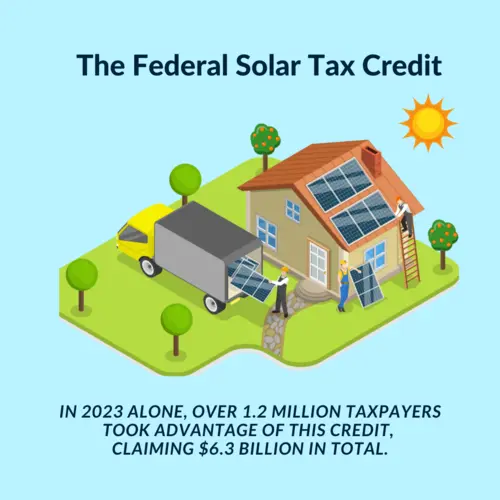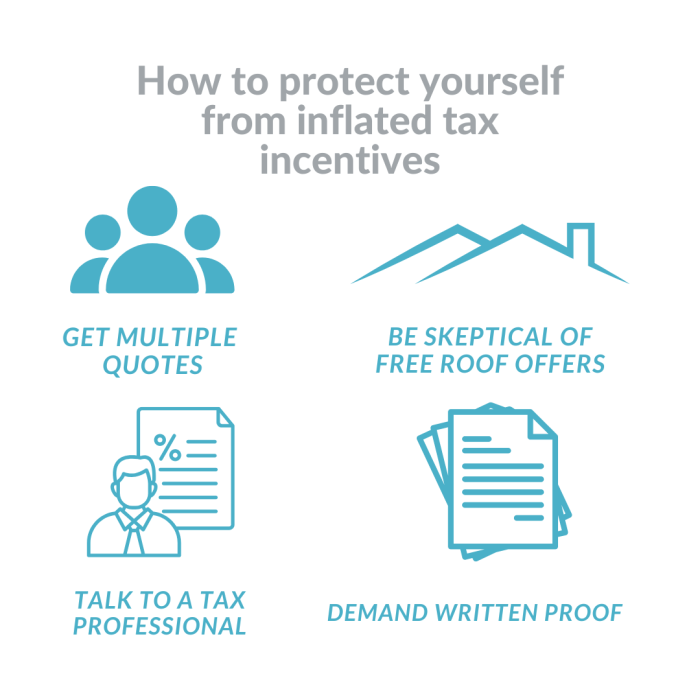The Federal Tax Credit Scam
No, It Doesn’t Cover Your New Roof
Many national solar sales reps tell homeowners that they can claim the 30% federal tax credit (ITC) on a new roof if it’s bundled with a solar energy installation. If a solar salesperson tells you this, walk away. It’s not true! The tax credit only applies to solar-related expenses, not home improvements like roof replacements.
New Roof With Solar Panels?
Imagine this: You’re sitting at your kitchen table, sipping your morning coffee, when a friendly solar sales rep knocks on your door. They promise that not only can you harness the sun’s energy, but you can also claim a 30% federal tax credit on a brand-new roof if it’s bundled with a solar installation.
Homeowners can claim a 30% federal tax credit under the Residential Clean Energy Credit. Data from 2023 shows over 1.2 million taxpayers took advantage of this credit, claiming around $6.3 billion in total, or over $5,000 per person.
Does A New Roof Qualify For Solar Tax Credits?
The allure of upgrading your home with solar panels is undeniable, especially with the promise of federal incentives.
The 30% federal tax credit under the Residential Clean Energy Credit is a major incentive for homeowners switching to solar. In 2023 alone, over 1.2 million taxpayers took advantage of this credit, claiming $6.3 billion in total, or an average of $5,000 per person.
However, bad actors misuse this credit by falsely bundling new roofs into solar financing—misleading homeowners into thinking they’ll receive a bigger tax break than legally allowed.

But here’s the catch: traditional roofing materials and structural components don’t qualify. So, if your roof needs repairs or replacement before installing solar panels, those costs are not eligible for the tax credit. The only exception is for solar roofing tiles or shingles that generate electricity.
For example, if you install a solar system that costs $20,000, you could receive a tax credit of $6,000, lowering your overall costs.
Here’s what the IRS Says: the credit can apply to “solar-ready improvements” only if they are necessary for installing the solar system and serve no other purpose beyond supporting that system.
That might include special solar shingles or a solar-integrated roofing system—but not your typical roof re-shingling, repair, or full replacement.
What Qualifies for the 30% Tax Credit?
- Solar panels, inverters, and mounting hardware
- Solar battery storage (like the Tesla Powerwall and FranklinWH, if primarily charged with solar energy)
- Electrical upgrades related to solar
- Solar water heaters
- Labor for installation and setup (including panel mounting, wiring, and system testing) is eligible.
What Doesn't Qualify for the 30% Tax Credit?
Shockingly, we’ve seen contracts from large national solar companies that spell out the 30% tax credit applying to both the roof and the solar system—as if it’s a guaranteed savings.
That’s simply not how the credit works. Including roof costs in tax credit projections is, at best, inaccurate—and at worst, intentionally deceptive. It sets up false expectations and leaves homeowners with surprise tax bills when the IRS doesn’t honor the full deduction.
- Traditional roofing materials (shingles, underlayment, etc.)
- A full roof replacement
- Electrical upgrades related to solar
- Structural work that isn’t directly tied to solar panel installation
- Exception: Solar roofing tiles or solar shingles (since they generate electricity) DO qualify
You Can Finance a New Roof with a Solar Loan
While a new roof doesn’t typically qualify for the tax credit, you may still be able to include the cost of the roof in your solar loan.
Many lenders allow homeowners to package roof work into a single solar loan, making it easier to move forward with both projects at once. That means you could:
- Bundle your roof replacement and solar installation into one monthly payment
- Take advantage of low-interest financing
- Avoid having to come up with separate cash for the roof
Just keep in mind: only the portion of the loan that covers the solar system (and eligible installation costs) is covered by the 30% federal tax credit. The roof portion can be financed, but it won’t reduce your tax bill.
While we are not tax experts, we can assure you that adding the cost of replacing your roof into the federal income tax credit equation is one way to dirty up your taxes, rather than gaining a clean credit. If a solar contractor tells you that the ITC will pay for your roof, that’s a red flag.
How This Scam Works
Some solar companies inflate your tax credit calculation by sneaking a full re-roof into the financed amount. This tricks homeowners into thinking they’ll get thousands more back from the IRS than they actually will.
What to look out for: One example of a quote you may see includes a full re-roof cost in the financed amount and federal tax calculation, like these:
- Option 1: Standalone Solar
- Financed Amount: $56,133.22 (includes full re-roof)
- Federal Tax Credit Listed: $16,839.97
- Option 2: Bill Optimization Program
- Financed Amount: $73,374.60 (includes full re-roof)
- Federal Tax Credit Listed: $22,012.38

What You Can Do
If your roof is aging and you’re thinking about solar, we recommend the following steps:
- Evaluate the roof’s condition first If it has less than 10 years of life left, replacing it before going solar is the best path—but understand that it’s a separate expense from a tax perspective.
- Get estimates from licensed roofing professionals, not just solar installers.
- Talk to your tax advisor about what qualifies and what doesn’t—especially if your solar quote includes bundled roofing services.
- Work with a trusted solar provider that doesn’t make inflated claims about tax incentives.
- Ask whether a solar loan that includes roof costs is available, so you can manage everything under one payment plan—even if the roof portion isn’t eligible for tax credit.
How To Avoid Solar Scams?
Navigating the solar market can feel like walking through a minefield. Here are some practical tips to ensure you don’t get burned:
- Get Multiple Quotes: Always obtain estimates from at least two or three solar installation companies. This will give you a better idea of what the installation costs should be and whether the contractor is being upfront about the tax credit.
- Be Skeptical of “Free Roof” Offers: If a company offers a “free roof” along with the solar installation, ask for detailed information about costs and if roof replacement is necessary for the solar system.
- Consult a Tax Professional: Before making any decisions, it’s always a good idea to speak with a tax professional to understand how the tax credit works and how it applies to your finances.
- Read the Fine Print: Review the contract carefully before signing anything. If the installer promises to cover roof replacement costs through the tax credit, ask them to put it in writing. If they refuse or seem hesitant, that should concern you.
A solar tax credit won’t pay for your new roof—no matter what a smooth-talking salesperson tells you. If they claim otherwise, they’re either lying or clueless. Either way, don’t sign that contract. Instead, choose a solar company that’s transparent, follows the law, and actually has your best interests in mind. Protect your investment by working with a trusted, ethical solar provider that follows the law and puts your best interests first.
Remember, if something sounds too good to be true, it probably is. Always verify claims, consult with professionals, and do your research to ensure you’re making the best decision for your home and finances.